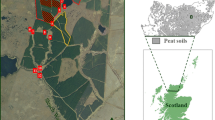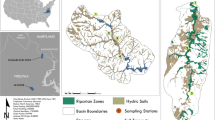Abstract
Plant productivity in many tropical savannas is phosphorus limited. The biogeochemical cycling of P in these ecosystems, however, has not been well quantified. In the present study, we characterized P stocks and fluxes in a well-preserved small watershed in the Brazilian Cerrado. As the Cerrado is also a fire-dominated ecosystem, we measured the P stocks and fluxes in a cerrado stricto sensu plot with complete exclusion of fire for 26 years (unburned plot) and then tested some predictions about the impacts of fire impacts on P cycling in an experimental plot that was burned three times since 1992 (burned plot). The unburned area is an ecosystem with large soil stocks of total P (1,151 kg ha−1 up to 50 cm depth), but the largest fraction is in an occluded form. Readily extractable P was found up to 3 m soil depth suggesting that deep soil is more important to the P cycle than has been recognized. The P stock in belowground biomass (0–800 cm) was 9.9 kg ha−1. Decomposition of fine litter released 0.97 kg P ha−1 year−1. Fluxes of P through bulk atmospheric deposition, throughfall and litter leachate were very low (0.008, 0.006 and 0.028 kg ha−1 year−1, respectively) as was stream export (0.001 kg ha−1 year−1). Immobilization of P by microbes during the rainy season seems to be an important mechanism of P conservation in this ecosystem. Fire significantly increased P flux in litter leachate to 0.11 kg ha−1 year−1, and added 1.2 kg ha−1 of P in ash deposition after fire. We found an increase of P concentration in soil solution at 100 cm depth (from 0.03 μg l−1 in unburned plot to 0.3 μg l−1 in the burned plot). In surface soils (0–10 cm) of the burned plot, fire decreased the concentrations of extractable organic-P fractions, but did not significantly increase inorganic-P fractions. The reduction of extractable soil organic P in the burned plot in topsoil and the increase of P in the soil solution at greater depths indicated a reduction of P availability and may increase P fixation in deep soils. Repeated fire events over the long term may result in significant net loss of available forms of phosphorus from this ecosystem.







Similar content being viewed by others
References
Araújo AG, Ayarza MA, Friesen DK, Vilela L (1996) Frações orgânicas e inorgânicas de fósforo em um solo de cerrado sob diferentes sistemas de manejo. Anais do III Congresso Brasileiro de Ecologia. Universidade de Brasília, Brasília, Brazil, pp 319–322
Bahia-Filho AFC, Braga JM, Resende M, Ribeiro AC (1983) Relação entre adsorção de fósforo e componentes mineralógicos da fração argila de latossolos do Planalto Central. Revista Brasileira de Ciência do Solo 7:221–226
Batmanian GJ, Haridasan M (1985) Primary production and accumulation of nutrients by the ground layer community of cerrado vegetation of central Brazil. Plant Soil 88:437–440
Cajuste LJ, Laird RJ, Cruz J, Cajuste L Jr (1994) Phosphate availability in tropical soils as related to phosphorus fractions and chemical tests. Commun Soil Sci Plant Anal 25:1881–1889
Castro-Neves BM, Miranda HS (1996) Efeitos do fogo no regime térmico do solo de um campo sujo de cerrado. In: Miranda HS, Saito CH, Dias BFS (eds) Impactos de queimadas em áreas de Cerrado e Restinga. Departamento de Ecologia-UnB, Brasília, Brazil, pp 20–30
Coutinho LM (1990) Fire in the ecology of the Brazilian Cerrado. In Goldammer JG (ed) Fire in the tropical biota, Ecological Studies 84. Springer-Verlag, Berlin, pp 82–105
Cross AF, Schlesinger WH (1995) A literature review and evaluation of Hedley fractionation: applications to the biogeochemical cycle of soil phosphorus in natural ecosystems. Geoderma 64-197-214
Demetz M, Insam H (1999) Phosphorus availability in a forest soil determined with a respiratory assay compared to chemical methods. Geoderma 89:259–271
Dockersmith IC, Giardina CP, Sanford RL Jr (1999) Persistence of tree related patterns in soil nutrients following slash-and-burn disturbance in the tropics. Plant Soil 209:137–156
Eiten G (1972) The cerrado vegetation of Brazil. Bot Rev 38:201–341
Fontes MPF, Weed SB (1996) Phosphate adsorption by clays from Brazilian Oxisols: relationships with specific surface area and mineralogy. Geoderma 72:37–51
Galang MA, Markewitz D, Morris LA (2010) Soil Phosphorus transformations under forest burning and laboratory heat treatments. Geoderma 155:401–408
Giardina CP, Sanford R Jr, Dockersmith I (2000) Changes in soil phosphorus and nitrogen during slash-and-burn clearing of a dry tropical forest. Soil Sci Soc Am J 64:399–405
Gonzales MI, Miranda HS, Moreira AG, Ribeiro MCLB, Franco AC (1997) Pesquisa ecológica de longo prazo em uma unidade de conservação do cerrado: Reserva Ecológica do IBGE. Anais do Congresso Brasileiro de Unidades de Conservação, Curitiba, Paraná, Brazil, pp 482–493
Grierson PF, Adams MA (2000) Plant species affect acid phosphatase, ergosterol and microbial P in a Jarrah (Eucalyptus marginata Donn ex Sm.) forest in south-western Australia. Soil Biol Biogeochem 32:1817–1827
Haridasan M (2001) Nutrient cycling as a function of landscape and biotic characteristics in the cerrado of central Brazil. In: McClain ME, Victoria RL, Richey JE (eds) Biogeochemistry of the Amazon basin and its role in a changing world. Oxford University Press, New York, pp 68–83
Hedley MJ, Stewart JWB, Chauhan BS (1982) Changes in inorganic and organic phosphorus fractions induced by cultivation practices and laboratory incubation. Soil Sci Soc Am J 46:970–976
Jensen M, Michelsen A, Gashaw M (2001) Responses in plant, soil inorganic and microbial nutrient pools to experimental fire, ash and biomass addition in a woodland savanna. Oecologia 128:85–93
Jobbágy EG, Jackson RB (2001) The distribution of soil nutrients with depth: global patterns and the imprint of plants. Biogeochemistry 53:51–77
Johnson AH, Frizano J, Vann DR (2003) Biogeochemical implications of labile phosphorus in forest soils determined by the Hedley fractionation procedure. Oecologia 135:487–499
Kauffman JB, Cummings DL, Ward DE (1994) Relationships of fire, biomass and nutrient dynamics along a vegetation gradient in the Brazilian cerrado. J Ecol 82:519–531
Lathwell DJ, Grove TL (1986) Soil–plant relationship in the tropics. Annu Rev Ecol Syst 17:1–16
Leal JR, Velloso CX (1973) Adsorção de fosfato em Latossolos sob vegetação de Cerrado. Pesquisa Agropecuária Brasileira 8:81–88
Lessa ASN (1998) Phosphorus dynamics in soils under slash and burn cultivation in the semi-arid northeast of Brazil. Ecotropicos 11:93–106
Letkeman LP, Tiessen H, Campbell CA (1996) Phosphorus transformations and redistribution during pedogenesis of western Canadian soils. Geoderma 71:201–218
Lilienfein J, Freibauer A, Neufeldt H, Westerhof R, Ayarza MA, Silva JE, Resck DVS, Zech W (1996) Influence of land-use on the distribution of water stable aggregates and P status of sandy and clayey Cerrado Oxisols, Brazil. Anais do III Congresso Brasileiro de Ecologia. Universidade de Brasília, Brasília, Brazil, pp 323–328
Lilienfein J, Wilcke W, Ayarza MA, Vilela L, Lima SC, Zech W (2000) Chemical fractionation of phosphorus, sulfur, and molybdenum in Brazilian savannah Oxisols under different land use. Geoderma 96:31–46
Lindsay WL, Vlek PLG, Chien SH (1989) Phosphate minerals. In: Dixon JB, Weed SB (eds) Minerals in soil environments. Soil Science Society of America, Madison, pp 1089–1130
Lopes AS, Cox FR (1979) Relação de características físicas, químicas e mineralógicas com fixação de fósforo em solos sob cerrados. Revista Brasileira de Ciências do Solo 3:82–88
Meinzer FC, Goldstein G, Franco AC, Bustamante M, Igler E, Jackson P, Caldas L, Rundel PW (1999) Atmospheric and hydraulic limitations on transpiration in Brazilian Cerrado woody species. Funct Ecol 13:273–282
Miranda AC, Miranda HS, Dias IFO, Dias BFS (1993) Soil and air temperatures during prescribed cerrado fires in Central Brazil. J Trop Ecol 9:313–320
Miranda HS, Rocha e Silva EP, Miranda AC (1996) Comportamento do fogo em queimadas de campo sujo. In: Miranda HS, Saito CH, Dias BFS (eds) Impactos de queimadas em áreas de Cerrado e Restinga. Departamento de Ecologia-UnB, Brasília, Brazil, pp 1–10
Murphy J, Riley JP (1962) A modified single solution method for the determination of phosphate in natural waters. Anal Chim Acta 27:31–36
Nardoto GB, Bustamante MMC (2003) Effects of fire on soil nitrogen dynamics and microbial biomass in savannas of Central Brazil. Pesquisa Agropecuária Brasileira 38:955–962
Nardoto GB, Bustamante MMC, Pinto AS, Klink CA (2006) Nutrient use efficiency at ecosystem and species level in savanna areas of Central Brazil and impacts of fire. J Trop Ecol 22:191–201
Nepstad DC, Carvalho CR, Davidson EA, Jipp PH, Lefebvre PA, Negreiros GH, Silva ED, Stone TA, Trumbore SE, Vieira S (1994) The role of deep roots in the hydrological and carbon cycles of Amazonian forests and pastures. Nature 372:666–669
Neufeldt H, Silva JE, Ayarza MA, Zech W (2000) Land-use effects on phosphorus fractions in Cerrado Oxisols. Biol Fertil Soils 31:30–37
Oksanen L (2001) Logic of experiments in ecology: is pseudoreplication a pseudoissue? Oikos 94:27–38
Oliveira RS (1999) Padrões sazonais de disponibilidade de água nos solos de um cerrado denso e um campo sujo e evapotranspiração. Dissertation, University of Brasília
Oliveira RS, Bezerra L, Davidson EA, Pinto F, Klink CA, Nepstad DC, Moreira A (2005) Deep root function in soil water dynamics in cerrado savannas of central Brazil. Funct Ecol 19:574–581
Pavinato PS, Merlin A, Rosolem CA (2009) Phosphorus fractions in Brazilian Cerrado soils as affected by tillage. Soil Tillage Res 105:149–155
Potter RL, Jordan CF, Guedes RM, Batimanian GJ, Han XG (1991) Assessment of a phosphorus fractionation method for soils: problems for further investigation. Agric Ecosyst Environ 34:453–463
Quesada CA, Miranda AC, Hodnett MG, Santos AJB, Miranda HS, Breyer LM (2004) Seasonal and depth variation of soil moisture in a burned open savanna (campo sujo) in central Brazil. Ecol Appl 14:s33–s41
Rantz SE (1982) Measurement and computation of stream flow: volume 1. Measurement of stage height and discharge. US Government Printing Office: Washington, DC, p 2175
Resende JCF (2001) A ciclagem de nutrientes em áreas de cerrado e a influência de queimadas controladas. Thesis, University of Brasília
Saá A, Trasar-Cepeda MC, Soto B, Gil-Torres F, Díaz-Fierros F (1994) Forms of phosphorus in sediments eroded from burnt soils. J Environ Qual 23:739–746
Santos JZL, Neto AEF, Resende AV, Curi N, Carneiro LF, Costa SEVGA (2008) Frações de fósforo em solo adubado com fosfatos em diferentes modos de aplicação e cultivado com milho. Revista Brasileira de Ciência do Solo 32:705–714
Silva FC (1990) Compartilhamento de nutrientes em diferentes em uma área de cerrado (Brasília-DF): chuva, produção e decomposição de liter. Dissertation, University of Brasília
Smeck NE (1973) Phosphorus: an indicator of pedogenetic weathering processes. Soil Sci 115(3):199–206
Tiessen H, Moir JO (1993) Characterization of available P by sequential extraction. In: Carter MR (ed) Soil sampling and methods of analysis. Lewis Publishers, Ann Arbor, pp 75–86
Vitousek PM (1984) Litterfall, nutrient cycling, and nutrient limitation in tropical forests. Ecology 65(1):285–298
Walker TW, Syers JK (1976) The fate of phosphorus during pedogenesis. Geoderma 15:1–19
Zar JH (1996) Biostatistical analysis, 3rd edn. Prentice & Hall, Upper Saddle River
Acknowledgments
The authors would like to acknowledge the assistance of Maria Regina Sartori da Silva, Hanry Coelho and Zayra Prado in field and laboratory work. The authors would like to acknowledge the support of laboratory of Plant and Soil Analyses of EMBRAPA Cerrados. The first author received scholarship from CNPq/Brazil through the Graduate Program in Ecology of the UnB. Financial support was provided by PELD/CNPq Program, Fundação de Apoio a Pesquisa do Distrito Federal (FAP/DF), A. W. Mellon Foundation, IAI/CRN 040, EPA Assistance Agreement CR827291 (LBA-ND-07), Grant No. NCC5-332 and S-10135-X of NASA’s Terrestrial Ecology Program/LBA. This paper has been reviewed in accordance with the U.S. Environmental Protection Agency’s peer and administrative review policies and approved for publication. Mention of trade names or commercial products does not constitute an endorsement or recommendation for use by the U.S. EPA.
Author information
Authors and Affiliations
Corresponding author
Rights and permissions
About this article
Cite this article
Resende, J.C.F., Markewitz, D., Klink, C.A. et al. Phosphorus cycling in a small watershed in the Brazilian Cerrado: impacts of frequent burning. Biogeochemistry 105, 105–118 (2011). https://doi.org/10.1007/s10533-010-9531-5
Received:
Accepted:
Published:
Issue Date:
DOI: https://doi.org/10.1007/s10533-010-9531-5




